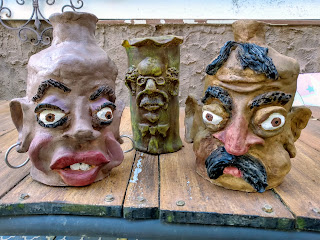CHARCOAL KILN EXPERIMENT
I had the idea of building the kiln inside our fire ring for safety, but as it burned I saw it wasn't necessary and, thinking the ring might impede air flow, I eventually removed it. To build my kiln, I first placed a piece of sheet metal on the ground and made the base on top of it. I happened to have these bricks with holes in them, and thought they would enhance air flow. I placed a small metal grate on bricks. Charcoal will go underneath this grate, and what I am calling the "core" of my kiln will set ontop.
This is the "core" of my kiln. It is part of an old kerosine heater that was in a pile of scrap metal. Tony Soares used a thick ceramic flower pot in his kiln, and suggests a galvanized bucket with a hole in the bottom or something similar if you don't have a flower pot.
Bricks were just stacked in a circular pattern to form a sort of cone shape with enough space to place charcoal around the kiln core. Charcoal will go under the grate and fill all the space between the core and the bricks.
I could only fit two pots in my core. However there was a little ridge on which I could set another grate and place a third pot. I cut this grate from an old metal basket. However, it melted and collapsed during the firing.
Here is my kiln, more or less. I added a couple more layers of bricks before I fired it up.
Here's the kiln full of charcoal -- one large bag of chunk charcoal and some of another bag of briquettes. There is a lot of charcoal in there. It seems expensive, but it will be good to know that I can fire my ceramic efforts at home.
I used starter fluid but the charcoal seemed slow to catch, and I used some twigs on top to finally get things going. Within an hour the fire had made it's way to the bottom of kiln. It took about three hours to burn down, and smoldered for several more. I measured a temp of 1600 degrees with an infrared thermometer through a space between bricks at one point.













Comments
Post a Comment